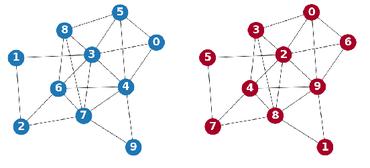Search Results for author: Yunsheng Bai
Found 13 papers, 6 papers with code
ProgSG: Cross-Modality Representation Learning for Programs in Electronic Design Automation
no code implementations • 18 May 2023 • Yunsheng Bai, Atefeh Sohrabizadeh, Zongyue Qin, Ziniu Hu, Yizhou Sun, Jason Cong
In addition, these programs can be compiled and converted into a control data flow graph (CDFG), and the compiler also provides fine-grained alignment between the code tokens and the CDFG nodes.
Code Recommendation for Open Source Software Developers
1 code implementation • 15 Oct 2022 • Yiqiao Jin, Yunsheng Bai, Yanqiao Zhu, Yizhou Sun, Wei Wang
In this paper, we formulate the novel problem of code recommendation, whose purpose is to predict the future contribution behaviors of developers given their interaction history, the semantic features of source code, and the hierarchical file structures of projects.
Dual-Geometric Space Embedding Model for Two-View Knowledge Graphs
1 code implementation • 19 Sep 2022 • Roshni G. Iyer, Yunsheng Bai, Wei Wang, Yizhou Sun
For works that seek to put both views of the KG together, the instance and ontology views are assumed to belong to the same geometric space, such as all nodes embedded in the same Euclidean space or non-Euclidean product space, an assumption no longer reasonable for two-view KGs where different portions of the graph exhibit different structures.
Detecting Small Query Graphs in A Large Graph via Neural Subgraph Search
no code implementations • 21 Jul 2022 • Yunsheng Bai, Derek Xu, Yizhou Sun, Wei Wang
In this paper, we propose NSUBS with two innovations to tackle the challenges: (1) A novel encoder-decoder neural network architecture to dynamically compute the matching information between the query and the target graphs at each search state; (2) A novel look-ahead loss function for training the policy network.
Enabling Automated FPGA Accelerator Optimization Using Graph Neural Networks
no code implementations • 17 Nov 2021 • Atefeh Sohrabizadeh, Yunsheng Bai, Yizhou Sun, Jason Cong
High-level synthesis (HLS) has freed the computer architects from developing their designs in a very low-level language and needing to exactly specify how the data should be transferred in register-level.
Learning to Search for Fast Maximum Common Subgraph Detection
no code implementations • 1 Jan 2021 • Yunsheng Bai, Derek Qiang Xu, Yizhou Sun, Wei Wang
Detecting the Maximum Common Subgraph (MCS) between two input graphs is fundamental for applications in biomedical analysis, malware detection, cloud computing, etc.
Bi-Level Graph Neural Networks for Drug-Drug Interaction Prediction
no code implementations • 11 Jun 2020 • Yunsheng Bai, Ken Gu, Yizhou Sun, Wei Wang
We introduce Bi-GNN for modeling biological link prediction tasks such as drug-drug interaction (DDI) and protein-protein interaction (PPI).
GLSearch: Maximum Common Subgraph Detection via Learning to Search
no code implementations • 8 Feb 2020 • Yunsheng Bai, Derek Xu, Yizhou Sun, Wei Wang
However, MCS computation is NP-hard, and state-of-the-art MCS solvers rely on heuristic search algorithms which in practice cannot find good solution for large graph pairs given a limited computation budget.
Neural Maximum Common Subgraph Detection with Guided Subgraph Extraction
no code implementations • 25 Sep 2019 • Yunsheng Bai, Derek Xu, Ken Gu, Xueqing Wu, Agustin Marinovic, Christopher Ro, Yizhou Sun, Wei Wang
Maximum Common Subgraph (MCS) is defined as the largest subgraph that is commonly present in both graphs of a graph pair.
Unsupervised Inductive Graph-Level Representation Learning via Graph-Graph Proximity
1 code implementation • 1 Apr 2019 • Yunsheng Bai, Hao Ding, Yang Qiao, Agustin Marinovic, Ken Gu, Ting Chen, Yizhou Sun, Wei Wang
We introduce a novel approach to graph-level representation learning, which is to embed an entire graph into a vector space where the embeddings of two graphs preserve their graph-graph proximity.
 Ranked #1 on
Graph Classification
on Web
Ranked #1 on
Graph Classification
on Web
Convolutional Set Matching for Graph Similarity
1 code implementation • 23 Oct 2018 • Yunsheng Bai, Hao Ding, Yizhou Sun, Wei Wang
We introduce GSimCNN (Graph Similarity Computation via Convolutional Neural Networks) for predicting the similarity score between two graphs.
Learning-based Efficient Graph Similarity Computation via Multi-Scale Convolutional Set Matching
1 code implementation • 10 Sep 2018 • Yunsheng Bai, Hao Ding, Yizhou Sun, Wei Wang
Since computing the exact distance/similarity between two graphs is typically NP-hard, a series of approximate methods have been proposed with a trade-off between accuracy and speed.
SimGNN: A Neural Network Approach to Fast Graph Similarity Computation
2 code implementations • WSDM '19 Proceedings of the Twelfth ACM International Conference on Web Search and Data Mining 2019 • Yunsheng Bai, Hao Ding, Song Bian, Ting Chen, Yizhou Sun, Wei Wang
Our model achieves better generalization on unseen graphs, and in the worst case runs in quadratic time with respect to the number of nodes in two graphs.
 Ranked #1 on
Graph Similarity
on IMDb
Ranked #1 on
Graph Similarity
on IMDb









